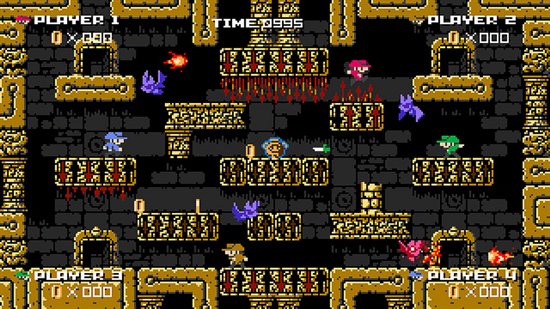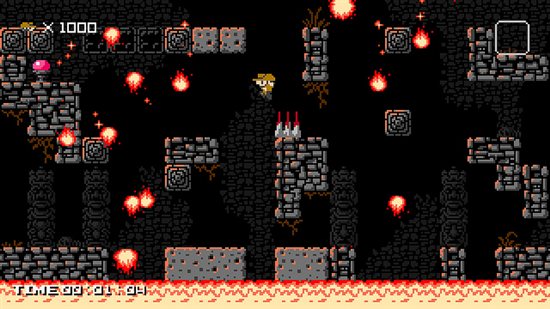Also On: PS4, Xbox One, PC, Wii U
Publisher: Nicalis
Developer: 8bits Fanatics
Medium: Digital
Players: 1
Online: No
ESRB: T
I suspect that if you were to make a Venn diagram of “People who like Spelunky” and “People who like 1001 Spikes”, you’d basically be drawing a circle. After all, the two games share quite a bit of DNA. Both are impossibly hard platformers. Both are heavily inspired by 8- and 16-bit games of yore. Both feature protagonists that look a lot like Indiana Jones, at least to the extent that little retro-looking game protagonists look like much of anything. I mean, there are a few relatively notable differences between the two, but as similar games go, these two are up there.
Of course, people with long, weirdly obsessive memories may recall that I wasn’t too fond of Spelunky and, consequently, wonder if my feelings are the same towards 1001 Spikes. To be blunt: yep. In fact, I’d say my thoughts on the two games are almost identical. Much like Spelunky, I can see why some people like 1001 Spikes. It’s an insanely difficult platformer that never lets up; every jump is a leap of faith, ever platform seems like it’s about to crumble, every wall hides deathly arrows and fire-breathing statues. It’s a demanding game, and if you’re in the market for that sort of thing, 1001 Spikes will totally meet your needs. (Of course, if you’re less fond of games that are constantly trying to kill you, then you might not enjoy it quite as much.)
As I said, though, there are a few differences between 1001 Spikes and Spelunky, and even if they’re seemingly minor, they’re enough that I can say I definitely prefer the former over the latter. Most obviously, there’s the core gimmick: for Spelunky, it was that every level was different every time, and you only had a couple of lives. In 1001 Spikes, by contrast, the levels stay the same, but you only have 1001 lives. That may sound like a lot, but, as I said, with all the ways this game can kill you, it’s really not. However, because the levels always stay the same, there’s a least a sense of fairness here, however skewed; you’re going to die frequently, but at least you’ll be given the chance to figure out why you died and how to get around each and every trap.
On a broader note, 1001 Spikes definitely feels much more like a genuine game from the 8-bit era. By this, I mean that I could totally imagine playing this on the NES. The graphics, the music, the way the (surprisingly deep, plotwise) cutscenes are animated: all of them are straight out of 1988 or so, to the point that I could get in a time machine, show the game to 8-year-old me, and have 1988-Matthew think the game was just like everything else he/I was playing at the time.
Of course, in a way, that just means the game is just as much of 2014 as it is of 1988, since it can also be slotted squarely alongside the seemingly countless other tough-as-nails platformers that populate the modern-day gaming landscape. Does 1001 Spikes do enough to really differentiate itself from that crowd? Honestly…not really, no. But if that’s your thing, then it’s at least good enough that it’s not a total waste of time, either.

